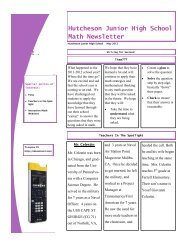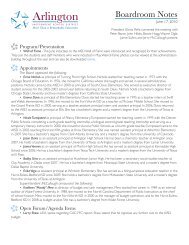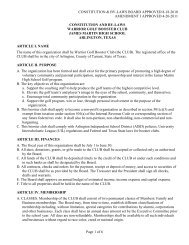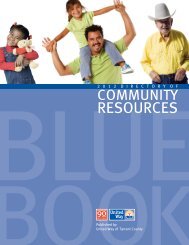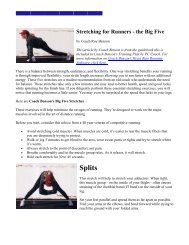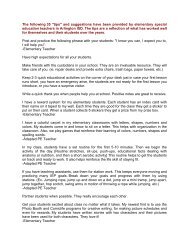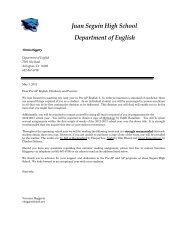Activity Description: In the classroom: The classroom teacher will ...
Activity Description: In the classroom: The classroom teacher will ...
Activity Description: In the classroom: The classroom teacher will ...
- No tags were found...
Create successful ePaper yourself
Turn your PDF publications into a flip-book with our unique Google optimized e-Paper software.
AISD Library Media <strong>In</strong>structional Plan<br />
Date: 12/2007 Grade Level: 2 Campus: Dunn<br />
Lesson Topic: Bears and Blubber: Arctic Survivor<br />
CONTENT AREA: Science<br />
TEKS/TAKS OBJECTIVES:<br />
2.6.d <strong>The</strong> student is expected to observe and record <strong>the</strong> functions of animal parts.<br />
2.9.a <strong>The</strong> student is expected to identify <strong>the</strong> external characteristics of different<br />
kinds of plants and animals that allow <strong>the</strong>ir needs to be met.<br />
2.9.b <strong>The</strong> student is expected to compare and give examples of <strong>the</strong> ways that living<br />
organisms depend on each o<strong>the</strong>r and on <strong>the</strong>ir environments.<br />
FOCUS: How organisms meet basic needs.<br />
MATERIALS/TECHNOLOGY: reference books and materials, online databases<br />
and websites, Little Polar Bear book, Dear Polar Bear book, construction paper,<br />
paper sacks, materials for experiment: see lesson plan.<br />
FINAL PRODUCT: Students <strong>will</strong> pack a “suitcase” of items for <strong>the</strong>m to take on a<br />
visit to Polar Bear in <strong>the</strong> arctic.<br />
KEY WORDS FOR LESSON BANK SEARCHING: arctic, polar bear, bear, bears,<br />
blubber, animal, animals, Little Polar Bear, Dear Polar Bear, Hans de Beer,<br />
Barry Ablett<br />
<strong>Activity</strong> <strong>Description</strong>:<br />
<strong>In</strong> <strong>the</strong> <strong>classroom</strong>:<br />
<strong>The</strong> <strong>classroom</strong> <strong>teacher</strong> <strong>will</strong> complete <strong>the</strong> following<br />
lesson/science experiment:<br />
Polar Bears<br />
By: Mandy Wallace<br />
http://atoz<strong>teacher</strong>stuff.com/pages/383.shtml<br />
Students <strong>will</strong> explain what keeps Polar Bears warm in<br />
<strong>the</strong> Arctic by experiencing a layer of blubber to<br />
protect <strong>the</strong>m.<br />
Materials:<br />
* Little Polar Bear by Hans de Beer<br />
* construction paper<br />
* sandwich bags<br />
* Crisco<br />
* bowl of water<br />
* ice cubes<br />
1
Plan:<br />
1. Show <strong>the</strong> students <strong>the</strong> cover of <strong>the</strong> book and ask for<br />
predictions.<br />
2. Read <strong>the</strong> book reminding students to look for <strong>the</strong><br />
different animals that <strong>the</strong> bear meets.<br />
3. After <strong>the</strong> story asks what o<strong>the</strong>r animals did <strong>the</strong><br />
polar bear meet<br />
4. Raise your hand if you think all <strong>the</strong>se animals could<br />
survive in <strong>the</strong> cold Arctic Why do you think this How<br />
do you think <strong>the</strong> Polar Bear survives <strong>the</strong> cold wea<strong>the</strong>r<br />
and swimming in <strong>the</strong> icy water<br />
5. Explain that polar bears have a layer of fat called<br />
blubber that keeps <strong>the</strong>m warm. Ask students what <strong>the</strong>y<br />
wear to keep warm<br />
6. Explain what <strong>the</strong> students <strong>will</strong> be doing at <strong>the</strong>ir<br />
seats, which is drawing pictures of clothing <strong>the</strong>y wear<br />
to keep warm.<br />
8. Students <strong>will</strong> <strong>the</strong>n complete <strong>the</strong> blubber glove<br />
experiment (directions below).<br />
To make <strong>the</strong> blubber glove, use two zip lock<br />
plastic bags and fill one with Crisco (about 1 cup).<br />
Use <strong>the</strong> o<strong>the</strong>r bag to place on top of <strong>the</strong> Crisco so <strong>the</strong><br />
students are not touching <strong>the</strong> Crisco. Attempt to zip<br />
toge<strong>the</strong>r by having <strong>the</strong> top one inside out.<br />
A bowl should be filled with water and ice, and<br />
<strong>the</strong> <strong>teacher</strong> should guide <strong>the</strong> students in putting <strong>the</strong><br />
glove on and putting <strong>the</strong>ir hand in <strong>the</strong> water. Tell <strong>the</strong>m<br />
to pretend <strong>the</strong>y are polar bears ready to dive into <strong>the</strong><br />
cold icy water.<br />
Students may touch water with one hand before or<br />
after using <strong>the</strong> glove to compare <strong>the</strong> difference of<br />
having <strong>the</strong> glove on and not having it on.<br />
National Science Foundation. http://nsf.gov<br />
Wallace, Mandy.<br />
http://atoz<strong>teacher</strong>stuff.com/pages/383.shtml<br />
2
<strong>In</strong> <strong>the</strong> library:<br />
<strong>The</strong> librarian <strong>will</strong> complete <strong>the</strong> following activity:<br />
Worldly Bears<br />
By Susan Ma<strong>the</strong>son<br />
Materials:<br />
Dear Polar Bear by Barry Ablett<br />
Plan:<br />
1. Read Dear Polar Bear to <strong>the</strong> class. Ask <strong>the</strong><br />
students to think of things that <strong>the</strong>y would send<br />
from here to <strong>the</strong> Polar Bear to help brighten up<br />
his home.<br />
2. Explain to <strong>the</strong> students that <strong>the</strong>y have been<br />
invited to visit <strong>the</strong> Polar Bear in <strong>the</strong> Arctic.<br />
<strong>The</strong>y must pack for <strong>the</strong> trip. <strong>The</strong>y <strong>will</strong> need to<br />
learn more about <strong>the</strong> Arctic in order to pack for<br />
<strong>the</strong> trip.<br />
3. Using <strong>the</strong> format of a bubble map work toge<strong>the</strong>r<br />
as a class to describe <strong>the</strong> arctic environment as<br />
described in <strong>the</strong> book.<br />
4. Students <strong>will</strong> <strong>the</strong>n use online and print<br />
resources to learn more about <strong>the</strong> arctic<br />
environment.<br />
5. As students find new information, <strong>the</strong>y <strong>will</strong> add<br />
<strong>the</strong>m to <strong>the</strong> class bubble map.<br />
6. Students <strong>will</strong> <strong>the</strong>n decide on <strong>the</strong> five items that<br />
<strong>the</strong>y <strong>will</strong> take on <strong>the</strong>ir trip.<br />
Lesson/<strong>Activity</strong> is completed in <strong>the</strong> <strong>classroom</strong>:<br />
7. <strong>The</strong> students <strong>will</strong> use construction paper to draw<br />
<strong>the</strong> items that <strong>the</strong>y would take with <strong>the</strong>m.<br />
8. <strong>The</strong> items <strong>will</strong> be packed in a paper sack that<br />
serves as a suitcase for <strong>the</strong> trip.<br />
3
9. Students <strong>will</strong> be given a chance to unpack <strong>the</strong>ir<br />
suitcase for <strong>the</strong> class and explain why <strong>the</strong>y<br />
brought each item.<br />
Notes:<br />
Ano<strong>the</strong>r option would be to have <strong>the</strong> polar bear visit his friends<br />
from <strong>the</strong> book. With this approach, <strong>the</strong> students would research <strong>the</strong><br />
different environments where those bears lived and pack a suitcase<br />
for <strong>the</strong> polar bear to take along.<br />
Students could also research <strong>the</strong> additional animals that are shown<br />
on <strong>the</strong> map but not part of <strong>the</strong> story. Students would be challenged<br />
to identify each animal and <strong>the</strong>n use that information to complete a<br />
product.<br />
Resources/Weblinks:<br />
Also included in attachment.<br />
Arctic Library –<br />
http://www.athropolis.com/gloss.htm<br />
Gander Academy –<br />
http://www.stemnet.nf.ca/CITE/pb_primary.htm<br />
People of <strong>the</strong> Arctic -<br />
http://www.saskschools.ca/~gregory/arctic/Apeople.html<br />
World Book for Kids<br />
http://www.worldbookonline.com/kids/Home<br />
Attachments: See Webliography document below– graphics<br />
courtesy of Microsoft Word.<br />
4
Arctic<br />
Survivor<br />
Arctic Library –<br />
http://www.athropolis.com/gloss.htm<br />
Gander Academy –<br />
http://www.stemnet.nf.ca/CITE/pb_primary.htm<br />
People of <strong>the</strong> Arctic -<br />
http://www.saskschools.ca/~gregory/arctic/Apeople.html<br />
World Book for Kids<br />
http://www.worldbookonline.com/kids/Home




